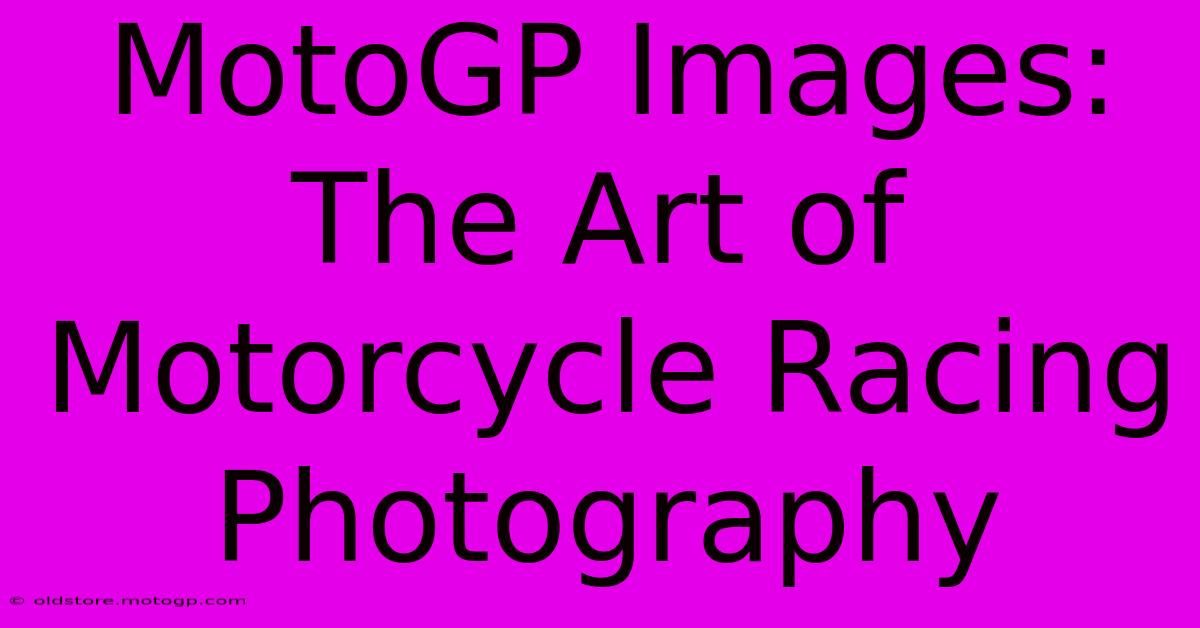MotoGP Images: The Art Of Motorcycle Racing Photography

Table of Contents
MotoGP Images: The Art of Motorcycle Racing Photography
MotoGP. The name conjures images of blistering speed, heart-stopping overtakes, and the roar of powerful engines. But beyond the adrenaline-fueled races lies a world of captivating photography, capturing the raw emotion and breathtaking skill of these incredible athletes. This article delves into the art of MotoGP photography, exploring the challenges, techniques, and artistry behind those stunning images that grace our screens and magazines.
The Challenges of Capturing Speed
Photographing MotoGP is no easy feat. The sheer speed of the bikes, often exceeding 200 mph (320 km/h), presents a significant challenge. Shutter speed is paramount; slow shutter speeds will result in blurry, unusable images. Photographers typically use extremely fast shutter speeds, often exceeding 1/2000th of a second, to freeze the action.
Mastering the Technical Aspects:
-
High-Speed Continuous Shooting: The ability to shoot multiple frames per second is crucial. Photographers need to capture the perfect moment amidst a flurry of activity, often selecting the best shot from a rapid burst.
-
Autofocus Precision: Accurate autofocus is essential. The bikes are fast-moving targets, requiring sophisticated autofocus systems that can track the subject with pinpoint accuracy. Predictive autofocus is a lifesaver in these situations.
-
Telephoto Lenses: Long telephoto lenses are indispensable, allowing photographers to capture close-up details of the riders and their machines from a safe distance. These lenses typically range from 400mm to 600mm or even longer, depending on the photographer's needs and location.
-
Understanding the Light: The lighting conditions at a MotoGP race can vary dramatically throughout the day, from bright sunshine to overcast skies. Mastering exposure compensation and understanding how different lighting conditions affect image quality is crucial.
Beyond the Technical: The Artistic Vision
While technical skill is essential, great MotoGP photography goes beyond mere technical proficiency. It's about capturing the essence of the sport – the drama, the tension, the raw power, and the human element.
Capturing the Emotion:
-
Rider Portraits: Close-up portraits of riders, capturing their determination, concentration, or exhaustion, can be incredibly powerful. These images convey the emotional toll and immense physical demands of the sport.
-
The Action Shots: Of course, the dynamic action shots are iconic. But to truly capture the art, it's about more than just freezing the speed. It's about choosing the right angle, the perfect moment, to convey the feeling of speed, competition, and risk.
-
Environmental Storytelling: The environment itself can add to the narrative. A dramatic sunset backdrop, the cheering crowd, or the technical details of the machines can all contribute to a compelling image.
The Equipment of Choice
While the exact equipment varies from photographer to photographer, several key pieces of equipment are commonly used in MotoGP photography:
-
Professional DSLR or Mirrorless Cameras: Cameras capable of handling high-speed continuous shooting and delivering high-resolution images are essential.
-
High-Quality Telephoto Lenses: As mentioned earlier, long telephoto lenses are crucial for capturing the action from a safe distance.
-
Fast Memory Cards: High-capacity, high-speed memory cards are necessary to keep up with the rapid-fire shooting required.
-
Monopods or Tripods: While often difficult to use due to space restrictions, stabilization tools can help minimize camera shake.
The Future of MotoGP Photography
With technological advancements, we can expect even more spectacular images from future MotoGP races. Improved camera technology, higher resolution sensors, and more sophisticated autofocus systems will allow photographers to capture even more detail and emotion. The use of drones and other innovative techniques could further expand the visual possibilities.
In Conclusion: MotoGP photography is a fascinating blend of technical skill and artistic vision. It's a challenging but incredibly rewarding field that provides viewers with a unique perspective on this exciting sport. The photographers who succeed are those who not only master the technical aspects but also have an eye for composition, timing, and the ability to capture the raw emotion and drama of the race.

Thank you for visiting our website wich cover about MotoGP Images: The Art Of Motorcycle Racing Photography. We hope the information provided has been useful to you. Feel free to contact us if you have any questions or need further assistance. See you next time and dont miss to bookmark.
Featured Posts
-
Conquer Any Track Race Motorcycles For Sale
Feb 22, 2025
-
Moto2 Specs Innovation In Motion
Feb 22, 2025
-
Houston Welcomes The World Of F1
Feb 22, 2025
-
Parking At Cota Insider Secrets And Map
Feb 22, 2025
-
Austin F1 Qualifying Setting The Stage For Sunday
Feb 22, 2025
